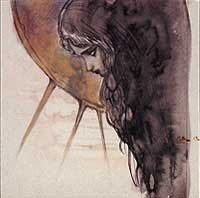One of my favourite illustrators of all time. I first discovered his work when i bought a video game, Final Fantasy for the playstation. Being a huge final fantasy fan i researched his work a long time ago.
This website is tells you everything you need to know about him.
He's also done work for Neil Gaiman the sandman and Vampire Hunter D
This is some of his Final Fantasy work















































